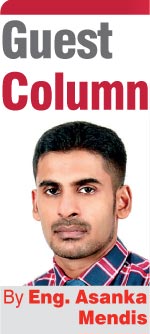Sunday Dec 07, 2025
Sunday Dec 07, 2025
Monday, 16 December 2024 00:00 - - {{hitsCtrl.values.hits}}

The circular sought to compel all engineers, including those with foreign qualifications or specialised knowledge in fields not recognised by IESL or IIESL, to conform to the ECSL’s registration requirements
|
 The Engineering Council Sri Lanka (ECSL) which was set up under Act No. 04 of 2017 started its active role by issuing Circular No. 01/2021 dated 28.07.2021 to all Government institutions and in general to all engineering professionals including those who work in the private sector and those who are self-employed. This circular issued following mandatory instructions.
The Engineering Council Sri Lanka (ECSL) which was set up under Act No. 04 of 2017 started its active role by issuing Circular No. 01/2021 dated 28.07.2021 to all Government institutions and in general to all engineering professionals including those who work in the private sector and those who are self-employed. This circular issued following mandatory instructions.
According to the above Circular, any Engineering Practitioner who is employed in the Government, private sector or engaged in self-employment in the engineering field had to register with ECSL. This Circular created a serious confusion among the relevant stakeholders as the ECSL Act defined only certain categories in the engineering field/profession as “Engineering Practitioners”. Sections 15 & 41 of the Act have interpreted the definition of “Engineering Practitioners” stated as below:
15. Any engineering practitioner who satisfies the respective qualifications and experience specified in the Schedule A hereto, may apply to be registered as an engineering practitioner, in such form and manner as the Council may determine by rules made in that behalf.
41. “Engineering Practitioner” means –
(a) Chartered Engineer; (b) Associate Engineer; (c) Affiliate Engineer; (d) Incorporated Engineer;
(e) Engineering Diplomate; (f) Engineering Technician, who possesses corresponding qualifications specified in Schedule A of the Act.
Section 14 of the Act mandated only those professionals classified under the six categories to register with the ECSL. The Act did not envisage a scenario where engineers who do not meet these criteria, including those holding foreign qualifications or working in specialised fields such as Marine Engineering, Biomedical Engineering, and other non-IESL/IIESL-recognised fields, would be subject to mandatory registration. There were other categories of Engineers who did not fall under the above six categories who engaged in the employment in the engineering field.
Few examples of other Engineering Professionals/Practitioners who do not fall under above six categories are:
Thirty nine Petitioners consisting of several Government engineering and technical trade unions filed three Writ Applications Nos. 577/2021, 597/2021 & 607/2021 in the Court of Appeal, challenging the above Circular issued by the Chairman, ECSL. All three Writ Petitions were heard before Honourable Judge of the Court of Appeal, Justice Mohammed Laffar. Observations of the Court were as follows:
Statutory overreach and ultra vires action by the ECSL
The Petitioners highlighted that the Circular sought to impose registration on all persons engaging in engineering, irrespective of whether they fall within the specified categories of “engineering practitioners” recognised by law. This, they argued, represented a gross statutory overreach. The Petitioners contended that Section 14 of the Act mandated only those professionals classified under the six categories to register with the ECSL.
The rule-making power conferred upon the ECSL under Section 39 of the Act is similarly limited to making rules concerning registration procedures, standards of practice, and maintaining the professional conduct of those already falling under the defined categories. The ECSL’s attempt to regulate professionals outside this scope constituted an unlawful exercise of power, and thus, the issuance of the circular was clearly ultra vires.
Violation of the petitioners’ legitimate expectations
The doctrine of legitimate expectation was a cornerstone of administrative law, safeguarding individuals from arbitrary state action, especially where long-standing practices have engendered reliance. The Petitioners argued that prior to the enactment of the Act in 2017, the engineering profession in Sri Lanka was largely self-regulated, with engineers engaging in their respective fields based on internationally recognised standards and practices. Engineers were not required to register with any central body, and many professionals relied on this autonomy when building their careers.
The Circular, by mandating registration and criminalising non-compliance, represented a significant shift in the regulatory landscape. The Petitioners asserted that they had a legitimate expectation that any such drastic regulatory changes would not be introduced without adequate consultation and legal basis. Furthermore, the expectation that professionals would not be required to register with a central body unless explicitly mandated by law was reasonable and legitimate, given the absence of any prior regulatory framework requiring such registration for a vast majority of engineers.
In this case, the Petitioners’ legitimate expectation was that their professional status and rights would not be unilaterally altered, particularly in a manner that could jeopardise their careers and livelihoods. The abrupt imposition of mandatory registration, combined with penal provisions for non-compliance, constituted a violation of this expectation. The ECSL, in acting without proper statutory authority, failed to give due regard to the legitimate reliance interests of the Petitioners, thereby violating principles of fairness in administrative action.
Discrimination and arbitrary favouritism
Another aspect of the Petitioners’ argument focused on the discriminatory and arbitrary nature of the Circular. They contended that the ECSL, through the Circular, has introduced a regulatory regime that disproportionately favours members of the Institute of Engineers, Sri Lanka (IESL) and the Institution of Incorporated Engineers, Sri Lanka (IIESL). The Petitioners emphasised that a majority of the ECSL’s members were drawn from these two professional bodies, creating an inherent bias in favour of engineers who possess qualifications recognised by these institutions. Consequently, the Circular sought to compel all engineers, including those with foreign qualifications or specialised knowledge in fields not recognised by IESL or IIESL, to conform to the ECSL’s registration requirements.
This effectively creates an exclusionary regime where professionals who were not affiliated with IESL or IIESL are marginalised, unable to register, and consequently, ineligible for employment or promotions within both the public and private sectors. The Petitioners submitted that the Circular’s requirement for mandatory registration, without accounting for the diversity of qualifications held by engineers, was not only discriminatory but also created an artificial monopoly within the profession. The result was that only a narrow group of engineers, those affiliated with IESL and IIESL, benefited from the regulatory scheme, while others were unlawfully excluded.
This argument was particularly persuasive as it highlighted the risk of regulatory capture, where a regulatory body like the ECSL, composed of representatives from certain professional groups, enacted rules that unduly benefit its members while excluding others. The Petitioners’ claim of arbitrary favouritism was supported by the composition of the ECSL and the disproportionate advantages conferred upon those who were members of IESL and IIESL, thereby contravening the fundamental principles enshrined in our legal system.
Failure to follow procedural requirements and absence of proper rule-making
It was also observed that the ECSL, in issuing the Circular, failed to comply with the procedural requirements prescribed by the Act. Specifically, Section 39 of the Act mandated that any rules made by the ECSL must be published in the Government Gazette, thereby ensuring transparency and public participation in the regulatory process. The Petitioners contend that the ECSL bypassed this requirement, opting instead to issue a Circular that carries the force of law without adhering to the statutory rule-making process.
The ECSL’s failure to follow the proper procedure was a serious flaw, as it deprived affected parties of the opportunity to challenge or provide input on the rules being promulgated. Furthermore, the absence of a properly defined hierarchy among engineering practitioners – one that accounts for both academic qualifications and practical experience – created confusion and uncertainty within the profession. It was argued that any attempt to regulate engineers without first establishing such a hierarchy was both arbitrary and irrational. This argument underscores the ECSL’s lack of preparedness and its failure to establish a coherent regulatory framework before issuing far-reaching directives through the Circular.
Final conclusions of the court
The ECSL’s issuance of Circular No. 01/2021 was ultra vires and exceeded the scope of its statutory mandate as prescribed under the Engineering Council, Sri Lanka Act. The Circular unlawfully expands the ECSL’s regulatory power to include professionals who are not classified as “engineering practitioners” under the Act, thereby infringing upon the rights of a vast majority of engineers in Sri Lanka. Furthermore, the Petitioners have convincingly argued that the Circular violated their legitimate expectations and imposed an unjust and discriminatory regulatory regime that disproportionately favours members of the IESL and IIESL.
The ECSL’s failure to follow proper rule-making procedures, as mandated by the Act, further undermined the validity of the Circular. It was noted by the Courts, in this context that, the court of law would always strive to restore fairness, prevent undue harm to any professional body, and ensured that the state authorities/bodies act within the scope of their lawful authority.
Court found that the conduct of ECSL was palpably wrong and legally unsustainable. The Petitioners have established a clear entitlement to the relief sought. Accordingly, reliefs sought were granted quashing Circular No. 01/2021, along with any effects or consequences arising from its issuance.
Message to the professional institutions
This decision of the Court of Appeal sends a clear message to all professional institutions that they should understand the broader limits and boundaries of the industries in which their membership represents. They should not expand their regulatory powers to infringe upon the rights of vast majority of professionals who do not belong to their membership. They should not act in a manner imposing an unjust and discriminatory regulatory regime that disproportionately favours their membership.
It should be further remembered that the court of law would always strive to restore fairness and prevent undue harm to the innocent victims of similar situations.
IESL and IIESL who were the architects of drafting the ECSL Act should act, in the future, with a broader mindset if they wish to implement any amendments to the Act. These esteemed professional institutions should remember that people are now very much vigilant of their activities after realising the threats posed by the Circular 01/2021. Hence any future amendments to the Act should be done with due transparency, giving adequate time to all concerned parties to express their views, without rushing to enact the legislature, like it was done in the first instance.
(The writer is Secretary, National Organisation of Engineering Professionals (NOEP) and Director, NOEP Foundation.)